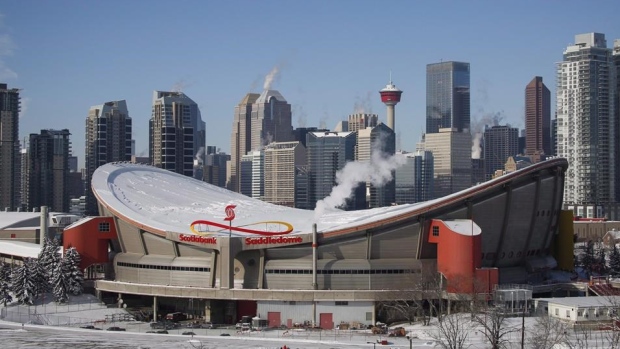Jan 28, 2022
Signs of optimism surround Flames’ arena negotiations
Nearly a month after the City of Calgary and Flames ownership abruptly cut off negotiations for a new arena, there is optimism an agreement can be reached in the first half of this year. Salim Valji has more.
By Salim Valji

Nearly a month after the City of Calgary and Flames ownership abruptly cut off negotiations for a new arena, there is optimism an agreement can be reached in the first half of this year.
Initially set to break ground in early 2022 a block from where the Saddledome currently stands, the original deal fell apart due to expense overruns related to climate mitigation and roads. Those overruns amounted to between $10 million and $20 million of the total facility cost of $608 million.
At a meeting in mid-January, city council – elected last October – voted to pursue a new agreement with Calgary Sports and Entertainment Corporation (CSEC), the parent company of the Flames. The difference now is that there would be a third party involved to shepherd the construction of the new facility – an arrangement more common in the United States than in Canada.
According to a source close to the negotiations, Oak View Group, founded by former Maple Leafs Sports & Entertainment CEO Tim Leiweke and has ownership stakes in Climate Pledge Arena in Seattle and UBS Arena on Long Island (among other facilities in North America), could be a candidate.
CSEC has yet to comment on council soliciting a third party to facilitate the construction of the new facility and declined comment to TSN on possibly re-entering discussions.
"Other cities have managed it differently,” mayor Jyoti Gondek said at a media conference earlier in January. “They've also got partners that are responsible for entertainment outside of sports. So, anything is possible at this point…I think it is a great way to ensure that everyone is getting what they need out of an agreement and a partnership by making sure there is a third party at the table, so that both interests are well-served.”
City council has a committee dedicated to the new arena project, including finding that third-party partner, and will present its findings in the spring.
That is surely welcome news for Flames fans pining for a new facility (opened in 1983, the Saddledome is the second-oldest rink in the NHL), as well as Calgarians hoping a new arena would help revitalize a downtown that has suffered from exorbitantly high vacancy rates due to oil prices bottoming out and the pandemic.
Despite the city council’s commitment to the facility, there remains the question of what the final price tag will ultimately be and just how much will be borne by the public.
Any major infrastructure project comes with a price, and should ground ultimately be broken, taxpayers will be footing the bill for at least some of the Flames’ new home. The city would have contributed more than $300 million to the construction of the new arena under the previous agreement. Several studies have shown, however, that taxpayer funding for professional sports facilities does not necessarily add to the city’s bottom line.
“Broadly speaking, the economic implications of [public funding for sports stadiums] are actually fairly minimal,” said Dr. Trevor Tombe, an economics professor at the University of Calgary.
“What it tends to do is shift economic activity across locations. So, if you were going to a game or going out for dinner at a bar or after, that’s spending from your household budget that would otherwise have gone to something else – maybe a restaurant or bar closer to where you live. An arena can change where that spending is done, so using something like an events centre to spur activity in a particular location in a city, that’s one thing. But for a city as a whole, the gains are pretty minimal, or almost nonexistent.”
Proponents of the project say the economic impact of a new arena would be felt by both hockey fans and non-fans alike and provide a major boost for Calgary as its downtown evolves and the city tries to lure residents into its core.
David Low, the executive director of the Victoria Park Business Improvement Area, points to Las Vegas’ T-Mobile Arena as an example for Calgary to follow.
“It is an amazing integration of arena and public realm, and interest,” he said. “You should be able to come down to the arena, not set foot in the building, not spend a dime, and still have an amazing experience. It’s got an amazing park. You can wander around…we could have done something or designed something of that nature. It’s designing that experience around the building. That’s where the real magic happens.”
Low feels that December’s arena impasse puts into doubt Flames ownership’s commitment to Calgary.
“This could have been a major catalyst to help get us out of the dumpster fire that we’re in, in terms of our single-track economy,” he said. “If you look at Las Vegas and Nashville right now, they are banging. Entertainment economies are some of the first to come back [from the pandemic]. So, to have that solid entertainment and culture engine would have been amazing…what should [CSEC] have done? They should have invested in Calgary and make us one of the top-three destinations in North America for conferences and events. That would have been the prize.”
In his December media conference announcing the deal’s termination, CSEC CEO John Bean did reaffirm their commitment to Calgary, saying that, “the people of Calgary should understand that nevertheless CSEC's intentions are to remain in the Scotiabank Saddledome."
For now, Calgarians will wait until the spring for further developments – and potentially longer on a new cost estimate – as the pandemic and the related supply chain disruptions go into a third year.

